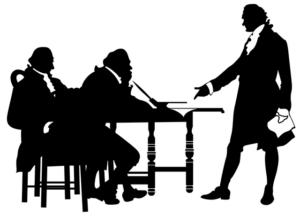by Jenny Powell MD
Let me tell you the story of the Great American Editing Project. On June 7, 1776, a fellow by the name of Richard Henry Lee filed a resolution (appropriately named “the Lee Resolution”) with the Second Continental Congress. He proposed a three-step process by which the united colonies of the Americas could declare independence from Great Britain. A committee was formed to draft a declaration; thus entered our Author, Thomas Jefferson.
The highly educated, soft spoken tall-drink-of-water out of rural Virginia was drafted by his committee of four others – which included writer Benjamin Franklin – to put something workable and agreeable on paper. While he drew upon some well known political writings, his goal was to give a face of unity before King George, to create the concept of an “American” people.
His first draft was subject to the editing of his fellow committee members. They trimmed and hemmed and hawed and suggested changes (I picture such as “should there be a comma here?” and “you shouldn’t refer to King George as a pompous donkey, Tom.”). But on June 28, the committee submitted their draft to the Second Continental Congress.
That’s when the real editing began.
Apparently it bothered Jefferson so much that years later he would show just about anyone he could a copy of HIS original (“SEE,” I imagine him saying, “I TOLD you my original draft was perfect.”). The Declaration certainly had detractors, folks who weren’t even convinced they should vote to leave the confines of British rule and those who refused to allow the 168-word anti-slavery comments Jefferson included. Okay, so he blames King George for single-handedly starting the African slave trade as well for the deaths incurred. That portion was struck with the red calligraphy pen.
This editing process took Congress a few long days, in the hot summer of Philadelphia, Pennsylvania, while the air conditioners worked overtime, thus causing blackouts every evening for weeks. To get a good idea of what it was like, one should visit Independence Hall in Philly at the end of June/early July. In a full suit. With the thought that you are probably going to be hanged for treason.
Finally, on July 2, 1776, congress adopted the highly edited revision of the Declaration of Independence, and the United States of America was born. Congressman John Adams of Massachusetts wrote to his wife, Abigail, about the day. “The Second Day of July 1776, will be the most memorable Epocha in the History of America. I am apt to believe that it will be celebrated, by succeeding Generations, as the great anniversary Festival. It ought to be commemorated, as the Day of Deliverance by solemn Acts of Devotion to God Almighty. It ought to be solemnized with Pomp and Parade, with Shews, Games, Sports, Guns, Bells, Bonfires and Illuminations from one End of this Continent to the other from this Time forward forever more.”
He got that right. However, the Declaration wasn’t even signed until August by the rest of Congress; only John Hancock signed it with his recognizable flourish on July 4. On June 28, 1870, Congress made July 4 a holiday for federal workers in Washington DC, and then it wasn’t until 1938 that it was declared a national holiday.
So, as you chow down on brats, light sparklers, and edit your first draft of your current manuscript, be glad that you are not Thomas Jefferson, pouting in Monticello that his editors destroyed his masterpiece but rejoice that they at least could come to an agreement in telling the world we are not Britons, but Americans.
 Jenny Powell MD is a family physician, thanks to a call from the Holy Spirit, with a unique practice style and two busy offices, available to her patients 24/7. When not writing prescriptions, she works on her unpublished manuscripts, reads a lot of novels, and supports ACFW writers. Visit Jenny on her website and Instagram @jpowellmdauthor.
Jenny Powell MD is a family physician, thanks to a call from the Holy Spirit, with a unique practice style and two busy offices, available to her patients 24/7. When not writing prescriptions, she works on her unpublished manuscripts, reads a lot of novels, and supports ACFW writers. Visit Jenny on her website and Instagram @jpowellmdauthor.

Comments 1
Well done on this Jenny!!! Perhaps you are unpublished for now… but in God’s time your work, which I have read and thoroughly enjoyed, will be published!!! Rev. Marsha Vincent